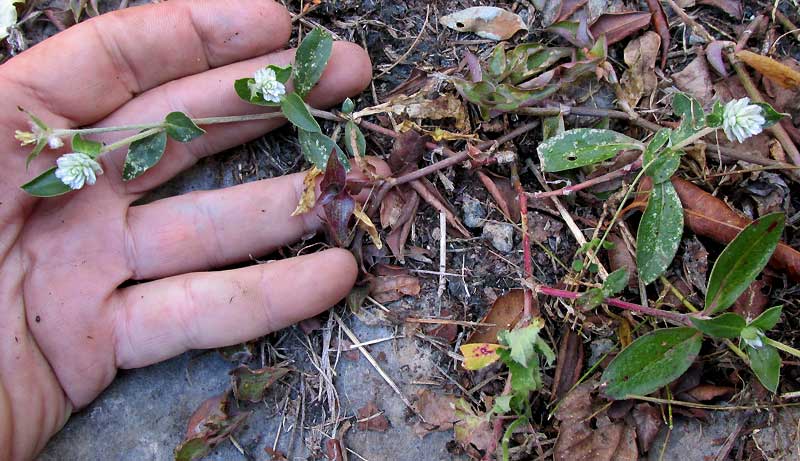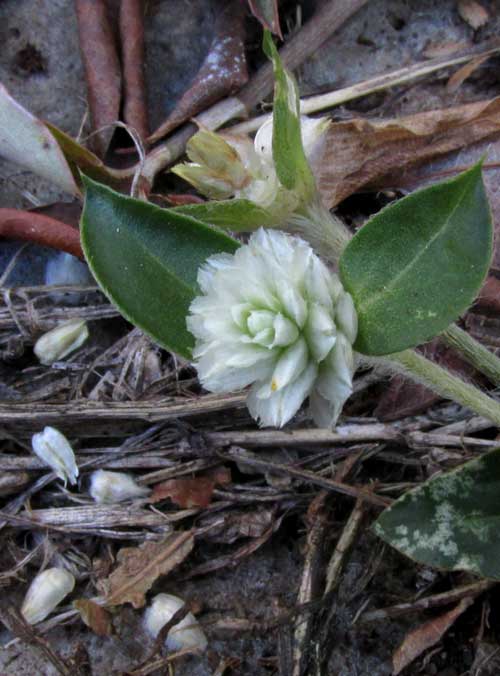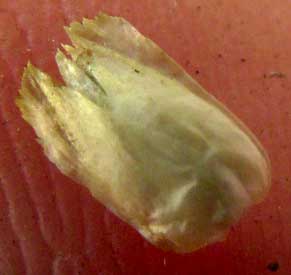Excerpts from Jim Conrad's
Naturalist Newsletter

from the February 7, 2016 Newsletter issued from Hacienda Chichen Resort beside Chichén Itzá Ruins; limestone bedrock; elevation ~39m (~128ft), N20.675°, W88.569°; central Yucatán state, MÉXICO
SMALL MATWEED
Last November at the rainy season's end I was surprised to find Mudplantain in a pool of water on an isolated trail. This week I returned to that spot interested in seeing what remained of that population. Nothing that I could find remained, just hard, thin, dry dirt atop limestone, some dried-up and dead herbaceous plants, and few green plants on the verge of drying up.
However, there was one small, ground-hugging plant doing better than the rest, drawing attention to itself with its pale, light-gathering flowering heads, as shown above.
Up close the heads were seen to consist of clusters of white, papery, scale-like items typical of the Amaranth Family, shown below:

So here's another "variation on the amaranth theme," a little plant whose stems and leaves are profoundly different from the above Chamissoa Vine's, while the chaffy flower clusters are very similar.
In the above picture several fruits with their papery scales attached lie on the ground, maybe dropped there by rabbits nibbling on the heads -- rabbits because rabbit poop lay nearby and nibbling such heads is just something rabbits might do. Also, the pale clusters show up in the deep shade and, presumably the night, so I can visualize rabbits attracted to the heads glowing in moonlight, nibbling the heads. The plant might "want" the rabbits to nibble its heads, counting on some seeds getting dropped and thus disseminated. Whatever knocked those fruiting units onto the ground, below, a close-up of one of them appears on the tip of my finger.
 Our little plant is GUILLEMINEA DENSA, widely distributed but usually little reported from the US states south through Mexico, plus from Colombia to Argentina in South America. It's scattered in the US, where it's considered an invasive, plus it's "gone wild in southern Africa and eastern Australia. In Mexico it's found mostly in the north-central states, at the same latitude as the Yucatan, and in similar environments. It's described as most frequent on trails and in sidewalk cracks, so our plant was just where it belonged.
Our little plant is GUILLEMINEA DENSA, widely distributed but usually little reported from the US states south through Mexico, plus from Colombia to Argentina in South America. It's scattered in the US, where it's considered an invasive, plus it's "gone wild in southern Africa and eastern Australia. In Mexico it's found mostly in the north-central states, at the same latitude as the Yucatan, and in similar environments. It's described as most frequent on trails and in sidewalk cracks, so our plant was just where it belonged.
By the way, the full binomial name of Guilleminea densa is Guilleminea densa (Humboldt & Bonpland ex Schultes) Moquin-Tandon, indicating that Alexander von Humboldt and Aimé Jacques Bonpland encountered it during their amazing expedition of discovery in tropical America from 1799 to 1804. Humboldt's account of that trip is fascinating reading, and can be downloaded for free at the Project Gutenberg site. I always have a little empathetic rush when I see the authorities "Humboldt & Bonpland" appended to the name of a plant turning up in my own life.